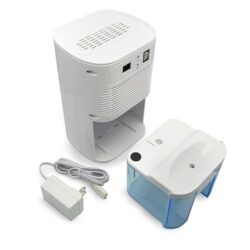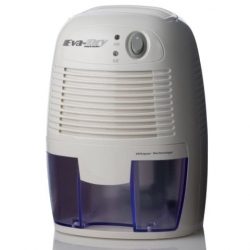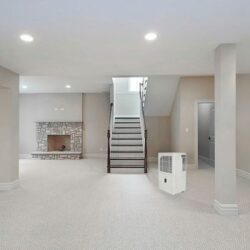10 Things to Consider When Going to Buy A Dehumidifier

For many people, a dehumidifier is a key household or workplace purchase. Whether it be for comfort and enjoyment or for health and wellness reasons, a dehumidifier can make a significant improvement in your indoor environment. Once you buy a dehumidifier, you may be surprised at the positive difference that optimal air humidity can make. Here are a few considerations to help guide you towards the best humidifier purchase for your needs.
1. Why do I need a dehumidifier?
The health benefits of dehumidifiers are well known. Leading health advisory organizations recommend that asthma and allergy sufferers avoid or minimize their symptoms by reducing the moisture of the air within their living spaces. Less moisture means less of the mold, mildew, bacterial growth, and dust mites that often lead to or aggravate respiratory suffering. For those without specific medical concerns, dehumidifiers increase comfort by replacing unpleasant muggy conditions with pleasant cool air. Reduced humidity also eliminates condensation on windows during cold seasons and helps prevent structural damage to the building that can be brought on by excess moisture. And it helps protect your belongings like electronics and books.
2. What type of dehumidifier do you need?
- Refrigerant (or compressor) dehumidifier
- Desiccant dehumidifier
There are two forms of dehumidifier technology: refrigerant- and desiccant-based dehumidifiers. The biggest difference between the two is their effectiveness in operating at lower vs. higher temperatures. Refrigerant-based dehumidifiers work by pulling in air that is then passed over cold, refrigerated coils, causing it to release moisture which drips into a container. The collected water is either manually emptied from the container or expelled from the dehumidifier through a hose. The remaining dry air is released back into the room.
Desiccant dehumidifiers remove humidity from the air by drawing in air and passing it over porous, moisture-absorbent material. The desiccant material is then heated, which allows the moisture it has collected to evaporate and be vented out of the building.While desiccants can still absorb humidity in cold conditions, refrigerant-based methods have a harder time condensing moisture out of the air at lower temperatures. So, refrigerant dehumidifiers are generally the preferred option at high temperatures and desiccant-based ones are the better option for colder environments. When they are operating at appropriate temperatures, refrigerant dehumidifiers are also able to remove a greater amount of moisture than desiccant ones.
3. How much space do I need to dehumidify?
The amount of space you plan to dehumidify is the major consideration for determining what capacity dehumidifier you should buy. Dehumidifier capacity, usually measured in pint, is a calculation of how much moisture the unit can remove from the air in a 24-hour time frame. Choosing a dehumidifier that is designated for the size of your space ensures you will get the desired results.
-
Small dehumidifier
Dehumidifiers can be as small as 24-ounce or 250 mL units. These types of mini-dehumidifiers are highly lightweight and portable, and can be convenient for single bedrooms, bathrooms and closets.
-
30 pint dehumidifier
Dehumidifier options for small single rooms like bedrooms and bathrooms include units that can remove up to approximately 30 pints of moisture per day. Of course, as with any smaller sized dehumidifiers, these units may need to be emptied more often than larger units.
-
50 pint dehumidifier
Fifty-pint capacity dehumidifier models are good options for medium-sized rooms and bathrooms with showers. They take up somewhat more space than the smaller options and are not as lightweight—but they remove a significantly higher volume of moisture, and are sometimes wheeled and therefore mobile.
-
70 pint dehumidifier
Dehumidifiers with capacities on the order of 70-pints are great for basements or large rooms, and areas that are more wet rather than just damp. They are more versatile at handling a broader set of humidity conditions.
-
Commercial dehumidifier
Commercial-grade dehumidifiers are available for the largest humidity extraction challenges. They draw in more air and extract more moisture than consumer market options. They are also manufactured for greater durability and mobility, and are able to operate well in a broader range of temperatures.
4. What’s my indoor temperature and humidity level?
Your indoor temperature and humidity levels are important factors impacting the performance of any dehumidifier. The higher the humidity level, the more important it will be to have a high-capacity unit. The lower the indoor temperature, the more likely it is that a dehumidifier’s performance will be compromised if it is a refrigerant-based model, and you should potentially consider a desiccant-based dehumidifier option instead. Also, dehumidifiers reach their capacity more quickly in higher-humidity conditions, and might require more frequent drainage.
5. How will I eliminate collected water?
Dehumidifiers operate by drawing and collecting the water out of the air, and they accumulate this excess water in internal containers that need to be emptied manually. Alternatively, in many cases dehumidifiers provide the option of drainage through a hose. If you have the possibility of draining your hose at ground-level, you need only direct it to a floor drain or to the out-of-doors to use this option. If not, you can often still use the continuous hose-drainage option by getting a pump accessory that will allow drainage into a sink.
6. Do I require any special features?
When choosing to buy a dehumidifier, it’s worth considering special features associated with different models.
-
User-Friendly Controls
User-friendly digital controls can allow you to set a specific humidity level by category (for example, “dry” or “very dry”) or by percentage. That way you have the power to customize the unit’s operation to address everything from a major humidity challenge like a flood, to a moderate lifestyle preference for slightly reduced humidity.
-
Auto Restart
Many models feature auto-restart, leaving you free of worry that your dehumidifier will continue working after a power outage is over.
-
Hose Connection
If you would like your dehumidifier to drain accumulated moisture into some external drainage outlet rather than into an internal container, you should confirm that it includes a hose connection. You should also confirm whether the necessary add-ons to use the hose drainage option are included with the unit or need to be purchased separately.
-
Timer
Dehumidifier timers allow you to program the unit operation to meet your specific home and lifestyle requirements. They provide you full control over operation start and stop times, without your presence being necessary.
-
Washable Air Filter
Washable air filters offer you the convenience of being able to easily and quickly clean any accumulation of particulates or bacteria, without having to go through the process of buying and replacing the filter.
-
Integrated humidistat
Humidistats measure the surrounding air moisture level, and those built in to dehumidifiers provide an easy method for you to monitor and adjust your unit’s operation to match your exact humidity preferences.
-
Constant drainage
You can avoid having to periodically empty the dehumidifier water collection container by choosing a unit with non-stop drainage capability. This way, the collected water runs through a hose into a drainage outlet of your choosing: a floor drain or out-of-doors area, or even into a sink. You should keep in mind that, depending on the dehumidifier model and the set-up of the space you are dehumidifying, in some cases you may need to purchase add-ons like an internal pump to fully benefit from these drainage solutions.
7. Where to place my dehumidifier?
 Dehumidifiers are appropriate for any space in your home or workplace: basements, bathrooms, bedrooms, living rooms, laundry rooms, kitchens, closets and crawl spaces. After you’ve selected the right size and capacity dehumidifier for your space, you should make sure the unit has proper airflow so that it can operate well: keep all vents about 20 cm from any wall or other obstruction. You might also choose to place the dehumidifier in a way that minimizes any operational noise.
Dehumidifiers are appropriate for any space in your home or workplace: basements, bathrooms, bedrooms, living rooms, laundry rooms, kitchens, closets and crawl spaces. After you’ve selected the right size and capacity dehumidifier for your space, you should make sure the unit has proper airflow so that it can operate well: keep all vents about 20 cm from any wall or other obstruction. You might also choose to place the dehumidifier in a way that minimizes any operational noise.
8. Does it have frost sensor?
If you plan to operate your dehumidifier during cold temperatures, you will benefit from a unit that includes a frost sensor. The sensor shuts down the dehumidifier when frost accumulates inside, before the unit sustains any damage.
9. How much do dehumidifiers cost?
Dehumidifier prices vary greatly, depending on factors like size, capacity, portability, durability and special features. Desiccant-based models are generally more expensive that refrigerant dehumidifiers. Keep in mind that it may be worth spending a little more to ensure the dehumidifier you buy will accomplish the goals you have in mind for your home or workspace.
10. Which are the best dehumidifiers?
Dehumidifier brands include, but are not limited to: GE, Haier, Kenmore, LG, and Whirlpool. The best dehumidifier is first and foremost the one that meets your specific needs. Once you have matched one or more models to your personal requirements, you might also consider the energy efficiency of the units you are choosing between. Many models are certified for energy performance, and when you are planning to buy a dehumidifier you can compare the power usage to select a unit that will not only do exactly what you need it to do, but also save on energy costs.
Final words
Buying a quality dehumidifier can help you maintain a comfortable and safe home or workplace environment that promotes wellness and productivity. There is a model on the market for every situation, and you are guaranteed to find the right fit for you. Pleasant and healthful air quality may be just one dehumidifier purchase away!
Tags: buy a dehumidifier
Categorised in: Buying Tips, Dehumidifier
















6 Comments
Warning: Undefined array key 180 in /www/wwwroot/thesoothingair.com/wp-content/themes/ultimateazon/functions.php on line 402
Thank you so much for this arlctie, it saved me time!
Warning: Undefined array key 180 in /www/wwwroot/thesoothingair.com/wp-content/themes/ultimateazon/functions.php on line 402
Great to hear 🙂
Warning: Undefined array key 180 in /www/wwwroot/thesoothingair.com/wp-content/themes/ultimateazon/functions.php on line 402
Oh yeah, fabuolus stuff there you!
Warning: Undefined array key 180 in /www/wwwroot/thesoothingair.com/wp-content/themes/ultimateazon/functions.php on line 402
Thats so sweet and kind of you dear. 🙂
Warning: Undefined array key 180 in /www/wwwroot/thesoothingair.com/wp-content/themes/ultimateazon/functions.php on line 402
People noralmly pay me for this and you are giving it away!
Warning: Undefined array key 180 in /www/wwwroot/thesoothingair.com/wp-content/themes/ultimateazon/functions.php on line 402
“The more you give, the more you get” . Thanks for your participation mate. Hope you liked these too.